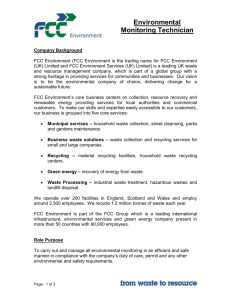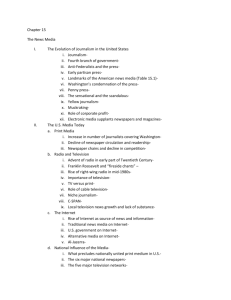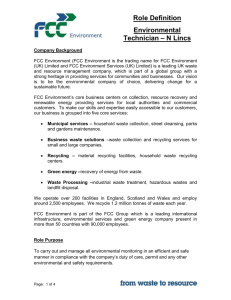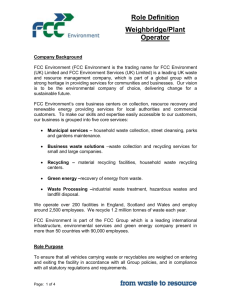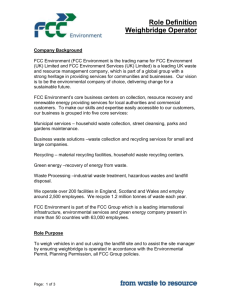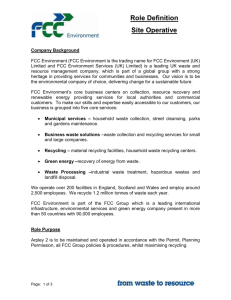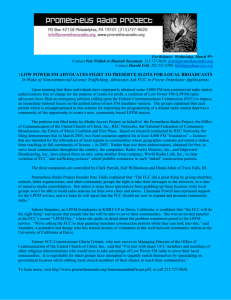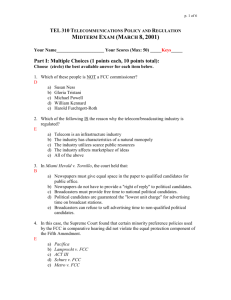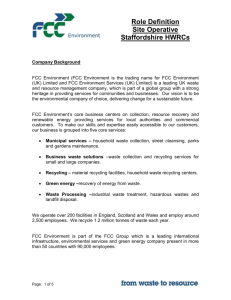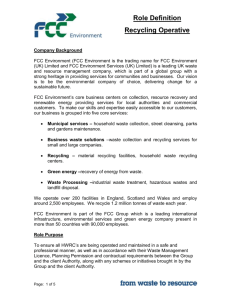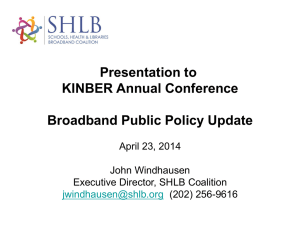FCC Regulations
advertisement
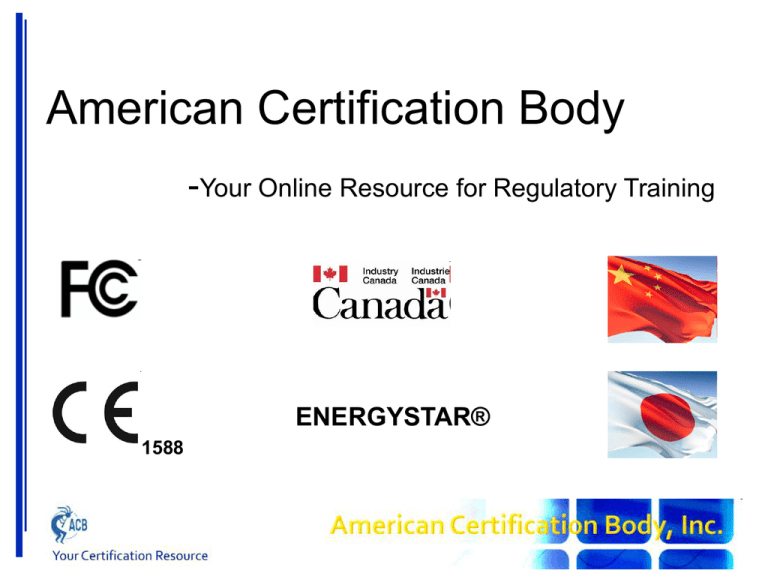
American Certification Body -Your Online Resource for Regulatory Training ENERGYSTAR® 1588 CFR 47 FCC Regulation Rule Parts • • • • • • • • • • Part 0 Commission Organization Part 1 Practice and Procedure Part 2 General Requirements Part 5 Experimental Radio Service Part 11 Emergency Alert Systems (EAS) Part 15 Subpart C, D, E Unlicensed Low Power Transmitters Part 20 Common Carrier Part 21 Domestic Public Service Part 22 Public Mobile Service Part 24 Licensed PCS CFR 47 FCC Regulation Rule Parts • • • • • • • • • • Part 25 Satellite Communication Services Part 26 General Wireless services Part 27 Miscellaneous Wireless Services Part 68 Telecom Services Part 73 Education Services Part 74 Television Broadcast Part 80 Maritime Service Part 87 Aviation Part 90 Private Land Mobile Part 95 Personal Radio Service CFR 47 FCC Regulation Rule Parts • Part 97 Amateur Radio • Part 100 Digital Satellite Broadcast (Eliminated and now requirements are in Part 25) • Part 101 Fixed Microwave Organization of the Equipment Authorization Process • Historical by nature • FCC enacted by Congress so rules are hard to change. • Written originally for Licensed transmitters • Provide the very first “pre-standards” rules for authorization of radio transmitters • Has been expanded several times as technology changes • ALL transmitters must be ‘Authorized’ to be legally used in the US Three methods of authorization Part 2J • Verification (2.902 and 2.951 to 2.956) – – – – – Manufacturer tests to limits Verifies compliance Maintains records No reporting to FCC required This however, DOES NOT mean devices are not tested • 2.955(3) states that the responsible ‘shall’ retain records of measurements including: – Name of test lab, data, description of how tested, support eq used, lengths of cables, modifications, test report signed by responsible party etc Three methods of authorization Part 2J • DoC (2.906 and 2.1071 to 2.1077 – Testing done by accredited and FCC recognized test lab • Lab must be accredited and must be either in the US of in a country with an active MRA with the US. (2.948(a)(3), 2.948(d)&(e)) – Product labeled with FCC DOC mark per 15.19 • DoC logo placed on equipment and DoC provided to end user • Improper use of DoC means the device is illegal. – Similar record retention as other authorization processes (2.1075) – Typically does NOT apply to intentional radiators under Part 15C Three methods of authorization Part 2J Certification (2.907 and 2.1031 to 2.1060) • Used for new equipment authorizations • Is more than just a “test report” – is in actually a legal document. • Requires a detailed list of “Exhibits” • 2.1033(b) for parts 11, 15 and 18 • 2.1033(c)for licensed. • Receives a grant of equipment authorization from FCC. • Records retained AND provided to FCC at time of grant (2.907(a)) Certification Process • Purpose of the grant – To define the capability and ratings of a transmitter for the FCC and other equipment users – To show the equipment is “Acceptable for Licensing” and what that use is • If the grant isn’t correct or clear then there may be issues getting user/site license when attempts to operate the device are done. – To signify that the device has been properly tested and may be marketed in the US • Compliance report should clearly state all modes of operation, which modes were tested and which were worst case. Certification Process • Uses of the grant • FCC licensing bureaus use the grant information to issue licenses to equipment users/stations – Incorrect information on the grant can lead to significant problems obtaining a license – The public regularly checks the details of a grant before purchasing a product – US Customs reviews grant information when products are imported into the United States – Many other countries will allow products to be imported based on the FCC approval and information on the grant Labeling • KDB784748 (contains policy and chart of applicability)
